MBA643 - Project Risk, Finance & Monitoring: Risk Management
VerifiedAdded on 2023/06/11
|9
|1765
|212
Report
AI Summary
This report assesses key measures for evaluating the financial viability of projects, focusing on selection, funding, cost management, and completion. It explores investment appraisal techniques like net present value, internal rate of return, and payback period, alongside budgeting systems to maximize profitability while minimizing investment risk. The report also discusses cost management strategies, including resource planning and budgeting, to control expenses and improve profitability. Different funding sources, both internal and external, are examined for their role in supporting project operations. Finally, it identifies factors for project rejection or closure, such as cost overruns and environmental concerns, and emphasizes risk mitigation methods and salvage options to minimize losses. Desklib offers a variety of study tools and solved assignments to aid in understanding these concepts.
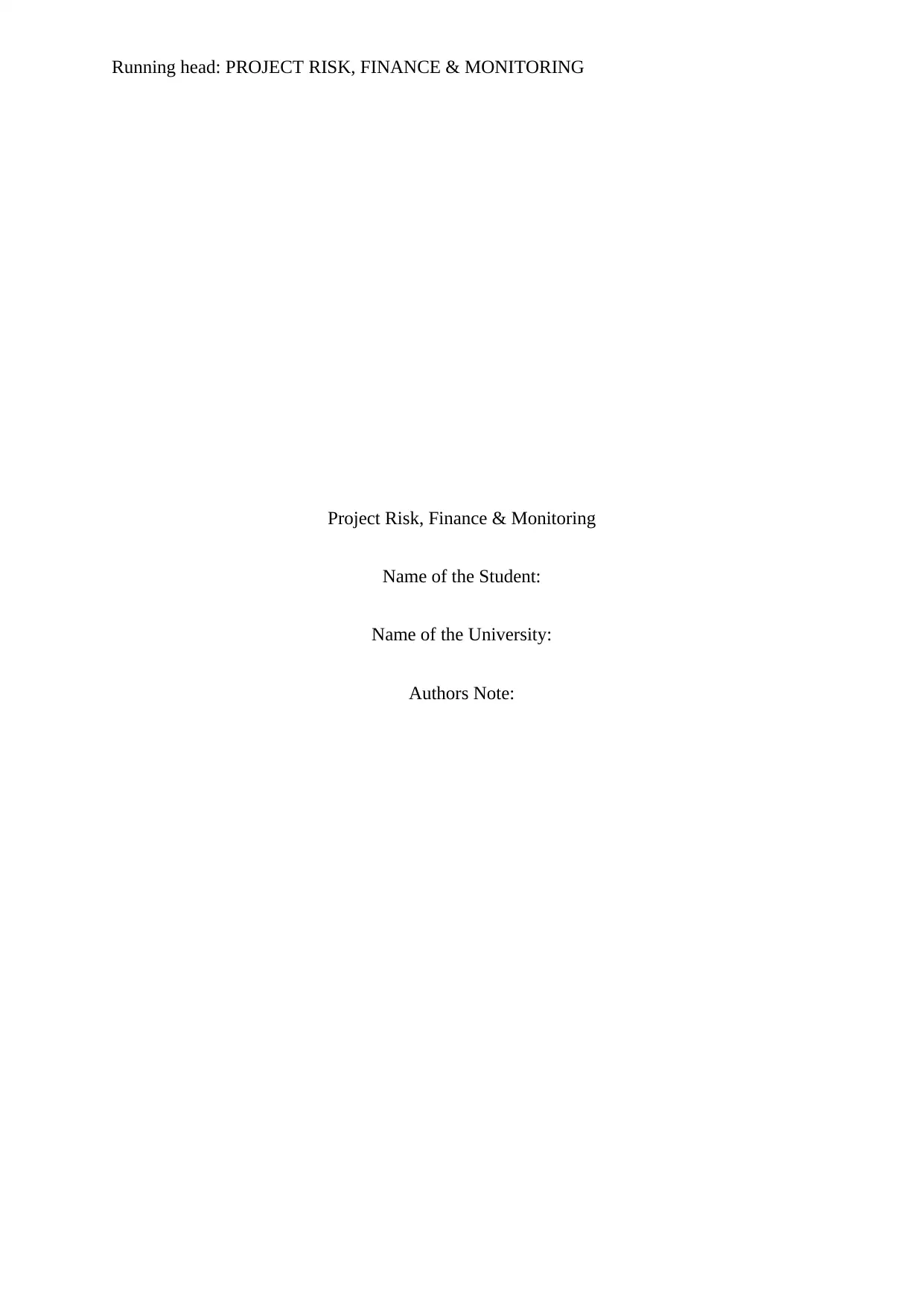
Running head: PROJECT RISK, FINANCE & MONITORING
Project Risk, Finance & Monitoring
Name of the Student:
Name of the University:
Authors Note:
Project Risk, Finance & Monitoring
Name of the Student:
Name of the University:
Authors Note:
Paraphrase This Document
Need a fresh take? Get an instant paraphrase of this document with our AI Paraphraser
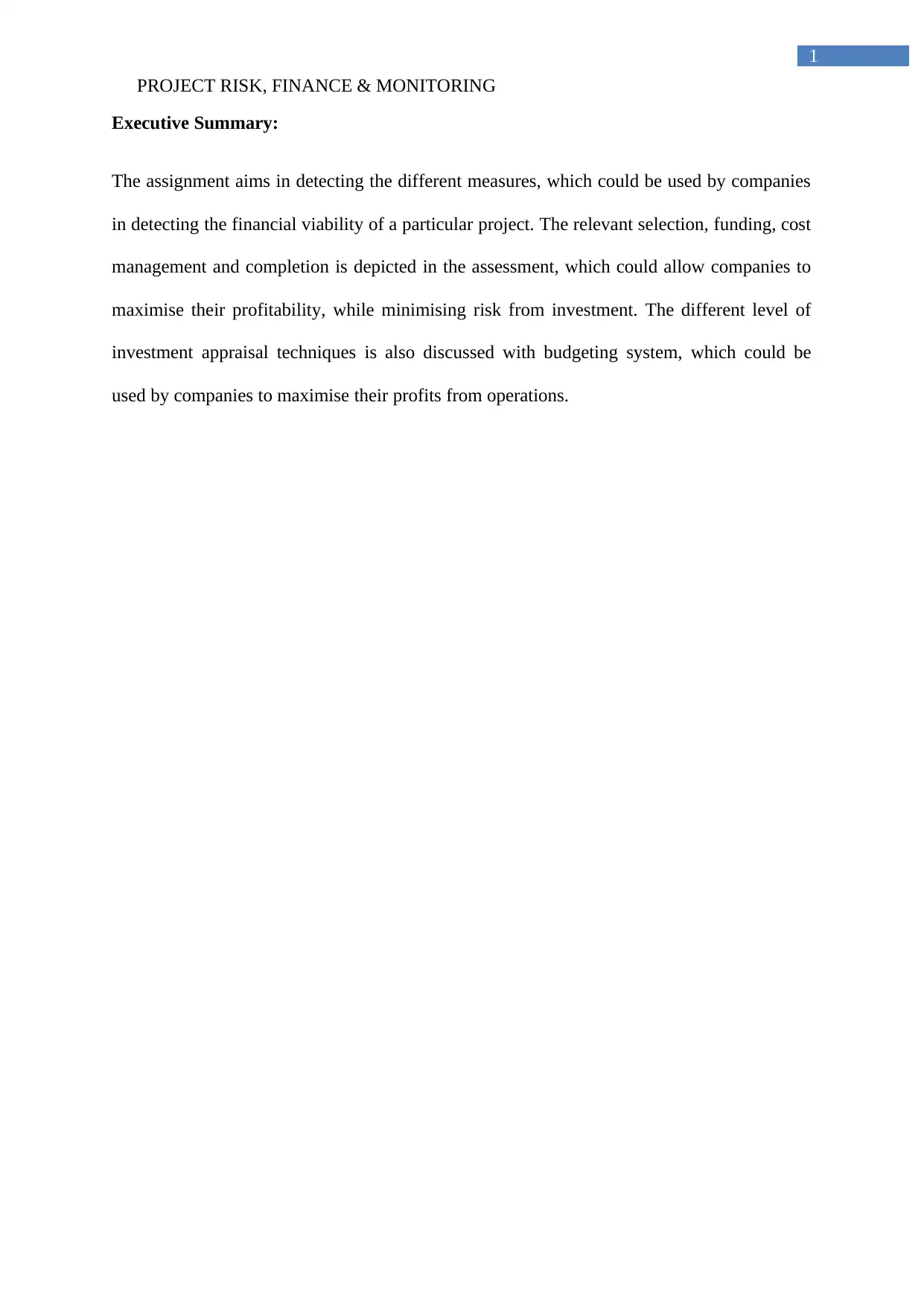
PROJECT RISK, FINANCE & MONITORING
1
Executive Summary:
The assignment aims in detecting the different measures, which could be used by companies
in detecting the financial viability of a particular project. The relevant selection, funding, cost
management and completion is depicted in the assessment, which could allow companies to
maximise their profitability, while minimising risk from investment. The different level of
investment appraisal techniques is also discussed with budgeting system, which could be
used by companies to maximise their profits from operations.
1
Executive Summary:
The assignment aims in detecting the different measures, which could be used by companies
in detecting the financial viability of a particular project. The relevant selection, funding, cost
management and completion is depicted in the assessment, which could allow companies to
maximise their profitability, while minimising risk from investment. The different level of
investment appraisal techniques is also discussed with budgeting system, which could be
used by companies to maximise their profits from operations.
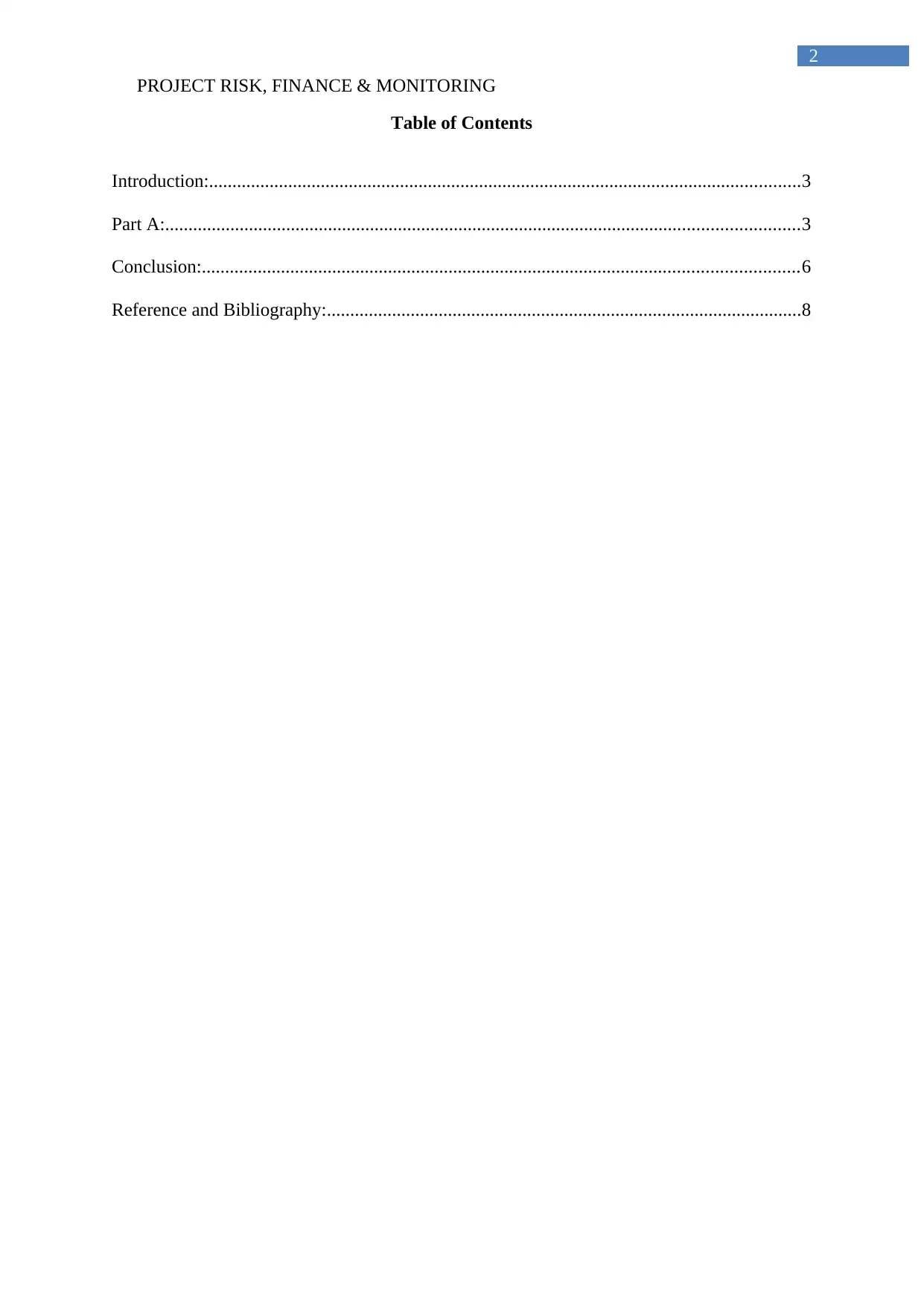
PROJECT RISK, FINANCE & MONITORING
2
Table of Contents
Introduction:...............................................................................................................................3
Part A:........................................................................................................................................3
Conclusion:................................................................................................................................6
Reference and Bibliography:......................................................................................................8
2
Table of Contents
Introduction:...............................................................................................................................3
Part A:........................................................................................................................................3
Conclusion:................................................................................................................................6
Reference and Bibliography:......................................................................................................8
⊘ This is a preview!⊘
Do you want full access?
Subscribe today to unlock all pages.

Trusted by 1+ million students worldwide
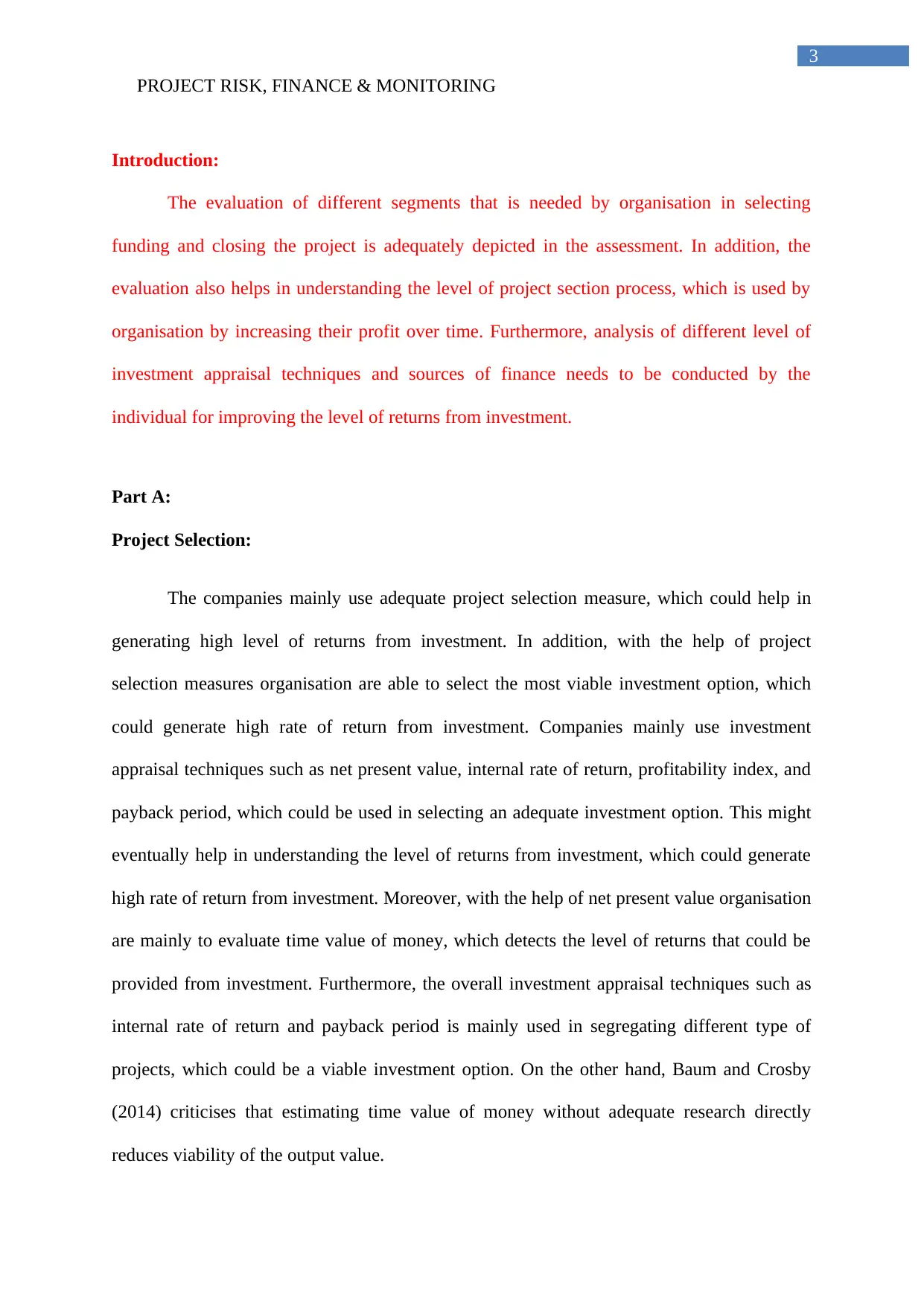
PROJECT RISK, FINANCE & MONITORING
3
Introduction:
The evaluation of different segments that is needed by organisation in selecting
funding and closing the project is adequately depicted in the assessment. In addition, the
evaluation also helps in understanding the level of project section process, which is used by
organisation by increasing their profit over time. Furthermore, analysis of different level of
investment appraisal techniques and sources of finance needs to be conducted by the
individual for improving the level of returns from investment.
Part A:
Project Selection:
The companies mainly use adequate project selection measure, which could help in
generating high level of returns from investment. In addition, with the help of project
selection measures organisation are able to select the most viable investment option, which
could generate high rate of return from investment. Companies mainly use investment
appraisal techniques such as net present value, internal rate of return, profitability index, and
payback period, which could be used in selecting an adequate investment option. This might
eventually help in understanding the level of returns from investment, which could generate
high rate of return from investment. Moreover, with the help of net present value organisation
are mainly to evaluate time value of money, which detects the level of returns that could be
provided from investment. Furthermore, the overall investment appraisal techniques such as
internal rate of return and payback period is mainly used in segregating different type of
projects, which could be a viable investment option. On the other hand, Baum and Crosby
(2014) criticises that estimating time value of money without adequate research directly
reduces viability of the output value.
3
Introduction:
The evaluation of different segments that is needed by organisation in selecting
funding and closing the project is adequately depicted in the assessment. In addition, the
evaluation also helps in understanding the level of project section process, which is used by
organisation by increasing their profit over time. Furthermore, analysis of different level of
investment appraisal techniques and sources of finance needs to be conducted by the
individual for improving the level of returns from investment.
Part A:
Project Selection:
The companies mainly use adequate project selection measure, which could help in
generating high level of returns from investment. In addition, with the help of project
selection measures organisation are able to select the most viable investment option, which
could generate high rate of return from investment. Companies mainly use investment
appraisal techniques such as net present value, internal rate of return, profitability index, and
payback period, which could be used in selecting an adequate investment option. This might
eventually help in understanding the level of returns from investment, which could generate
high rate of return from investment. Moreover, with the help of net present value organisation
are mainly to evaluate time value of money, which detects the level of returns that could be
provided from investment. Furthermore, the overall investment appraisal techniques such as
internal rate of return and payback period is mainly used in segregating different type of
projects, which could be a viable investment option. On the other hand, Baum and Crosby
(2014) criticises that estimating time value of money without adequate research directly
reduces viability of the output value.
Paraphrase This Document
Need a fresh take? Get an instant paraphrase of this document with our AI Paraphraser
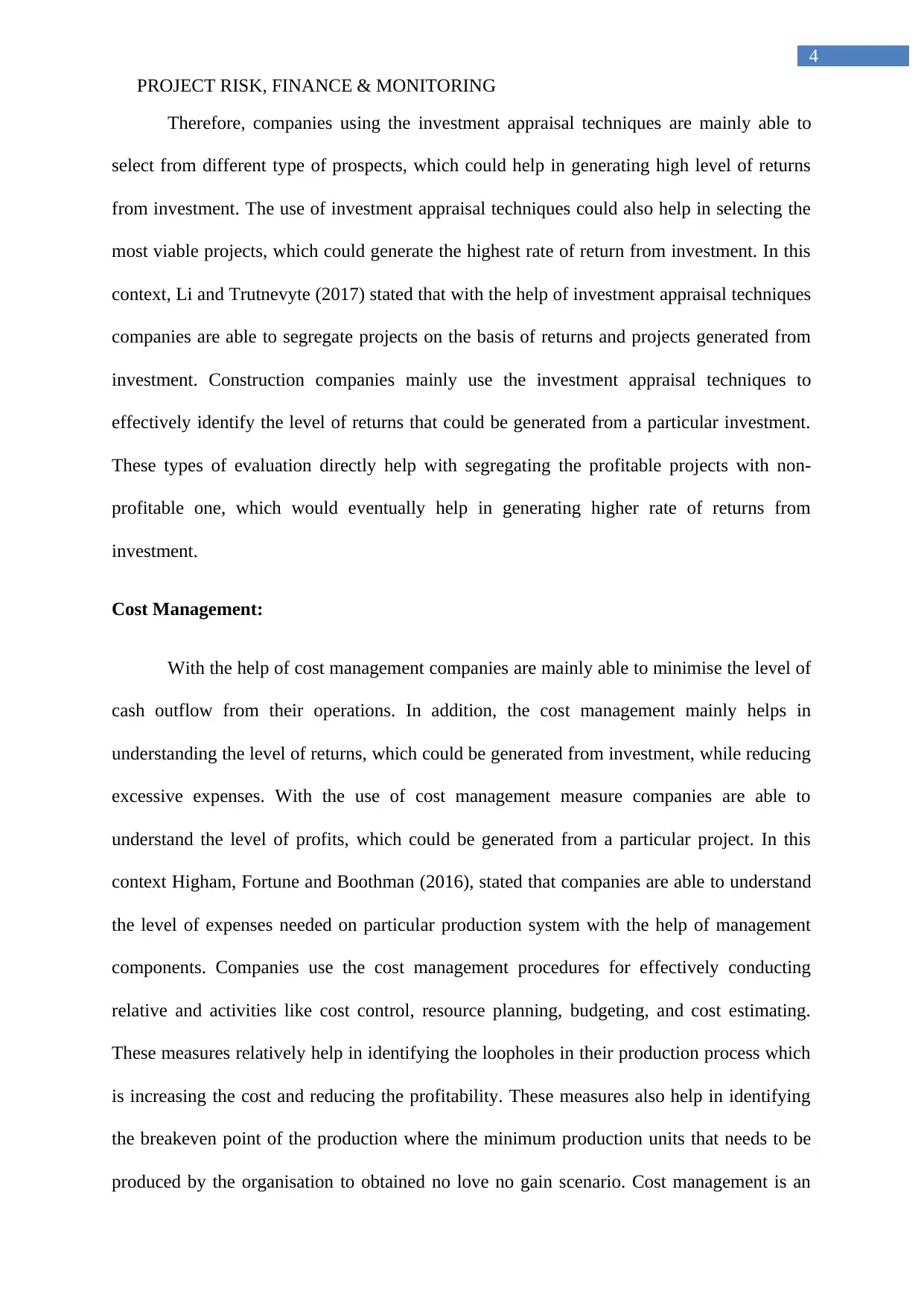
PROJECT RISK, FINANCE & MONITORING
4
Therefore, companies using the investment appraisal techniques are mainly able to
select from different type of prospects, which could help in generating high level of returns
from investment. The use of investment appraisal techniques could also help in selecting the
most viable projects, which could generate the highest rate of return from investment. In this
context, Li and Trutnevyte (2017) stated that with the help of investment appraisal techniques
companies are able to segregate projects on the basis of returns and projects generated from
investment. Construction companies mainly use the investment appraisal techniques to
effectively identify the level of returns that could be generated from a particular investment.
These types of evaluation directly help with segregating the profitable projects with non-
profitable one, which would eventually help in generating higher rate of returns from
investment.
Cost Management:
With the help of cost management companies are mainly able to minimise the level of
cash outflow from their operations. In addition, the cost management mainly helps in
understanding the level of returns, which could be generated from investment, while reducing
excessive expenses. With the use of cost management measure companies are able to
understand the level of profits, which could be generated from a particular project. In this
context Higham, Fortune and Boothman (2016), stated that companies are able to understand
the level of expenses needed on particular production system with the help of management
components. Companies use the cost management procedures for effectively conducting
relative and activities like cost control, resource planning, budgeting, and cost estimating.
These measures relatively help in identifying the loopholes in their production process which
is increasing the cost and reducing the profitability. These measures also help in identifying
the breakeven point of the production where the minimum production units that needs to be
produced by the organisation to obtained no love no gain scenario. Cost management is an
4
Therefore, companies using the investment appraisal techniques are mainly able to
select from different type of prospects, which could help in generating high level of returns
from investment. The use of investment appraisal techniques could also help in selecting the
most viable projects, which could generate the highest rate of return from investment. In this
context, Li and Trutnevyte (2017) stated that with the help of investment appraisal techniques
companies are able to segregate projects on the basis of returns and projects generated from
investment. Construction companies mainly use the investment appraisal techniques to
effectively identify the level of returns that could be generated from a particular investment.
These types of evaluation directly help with segregating the profitable projects with non-
profitable one, which would eventually help in generating higher rate of returns from
investment.
Cost Management:
With the help of cost management companies are mainly able to minimise the level of
cash outflow from their operations. In addition, the cost management mainly helps in
understanding the level of returns, which could be generated from investment, while reducing
excessive expenses. With the use of cost management measure companies are able to
understand the level of profits, which could be generated from a particular project. In this
context Higham, Fortune and Boothman (2016), stated that companies are able to understand
the level of expenses needed on particular production system with the help of management
components. Companies use the cost management procedures for effectively conducting
relative and activities like cost control, resource planning, budgeting, and cost estimating.
These measures relatively help in identifying the loopholes in their production process which
is increasing the cost and reducing the profitability. These measures also help in identifying
the breakeven point of the production where the minimum production units that needs to be
produced by the organisation to obtained no love no gain scenario. Cost management is an
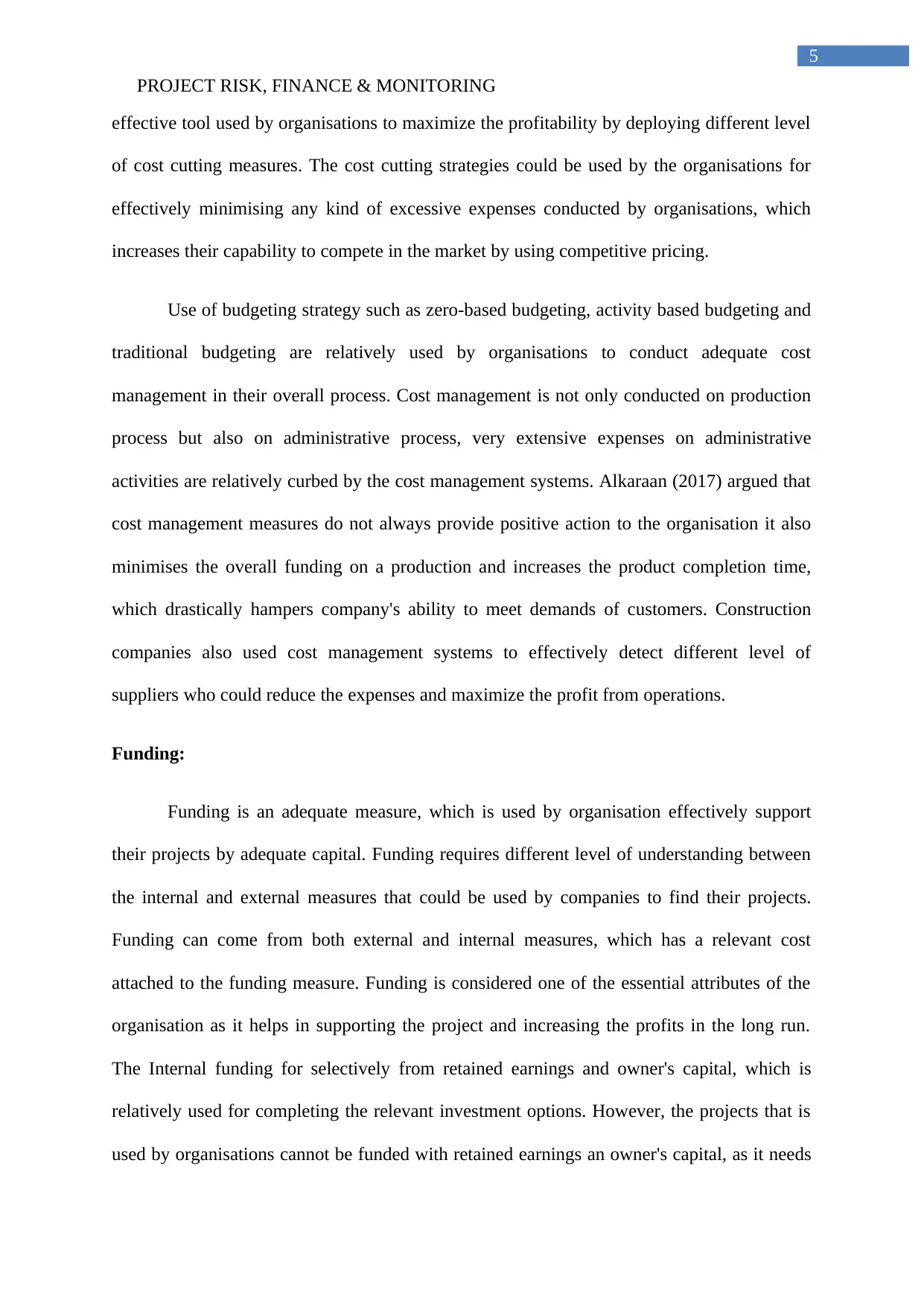
PROJECT RISK, FINANCE & MONITORING
5
effective tool used by organisations to maximize the profitability by deploying different level
of cost cutting measures. The cost cutting strategies could be used by the organisations for
effectively minimising any kind of excessive expenses conducted by organisations, which
increases their capability to compete in the market by using competitive pricing.
Use of budgeting strategy such as zero-based budgeting, activity based budgeting and
traditional budgeting are relatively used by organisations to conduct adequate cost
management in their overall process. Cost management is not only conducted on production
process but also on administrative process, very extensive expenses on administrative
activities are relatively curbed by the cost management systems. Alkaraan (2017) argued that
cost management measures do not always provide positive action to the organisation it also
minimises the overall funding on a production and increases the product completion time,
which drastically hampers company's ability to meet demands of customers. Construction
companies also used cost management systems to effectively detect different level of
suppliers who could reduce the expenses and maximize the profit from operations.
Funding:
Funding is an adequate measure, which is used by organisation effectively support
their projects by adequate capital. Funding requires different level of understanding between
the internal and external measures that could be used by companies to find their projects.
Funding can come from both external and internal measures, which has a relevant cost
attached to the funding measure. Funding is considered one of the essential attributes of the
organisation as it helps in supporting the project and increasing the profits in the long run.
The Internal funding for selectively from retained earnings and owner's capital, which is
relatively used for completing the relevant investment options. However, the projects that is
used by organisations cannot be funded with retained earnings an owner's capital, as it needs
5
effective tool used by organisations to maximize the profitability by deploying different level
of cost cutting measures. The cost cutting strategies could be used by the organisations for
effectively minimising any kind of excessive expenses conducted by organisations, which
increases their capability to compete in the market by using competitive pricing.
Use of budgeting strategy such as zero-based budgeting, activity based budgeting and
traditional budgeting are relatively used by organisations to conduct adequate cost
management in their overall process. Cost management is not only conducted on production
process but also on administrative process, very extensive expenses on administrative
activities are relatively curbed by the cost management systems. Alkaraan (2017) argued that
cost management measures do not always provide positive action to the organisation it also
minimises the overall funding on a production and increases the product completion time,
which drastically hampers company's ability to meet demands of customers. Construction
companies also used cost management systems to effectively detect different level of
suppliers who could reduce the expenses and maximize the profit from operations.
Funding:
Funding is an adequate measure, which is used by organisation effectively support
their projects by adequate capital. Funding requires different level of understanding between
the internal and external measures that could be used by companies to find their projects.
Funding can come from both external and internal measures, which has a relevant cost
attached to the funding measure. Funding is considered one of the essential attributes of the
organisation as it helps in supporting the project and increasing the profits in the long run.
The Internal funding for selectively from retained earnings and owner's capital, which is
relatively used for completing the relevant investment options. However, the projects that is
used by organisations cannot be funded with retained earnings an owner's capital, as it needs
⊘ This is a preview!⊘
Do you want full access?
Subscribe today to unlock all pages.

Trusted by 1+ million students worldwide
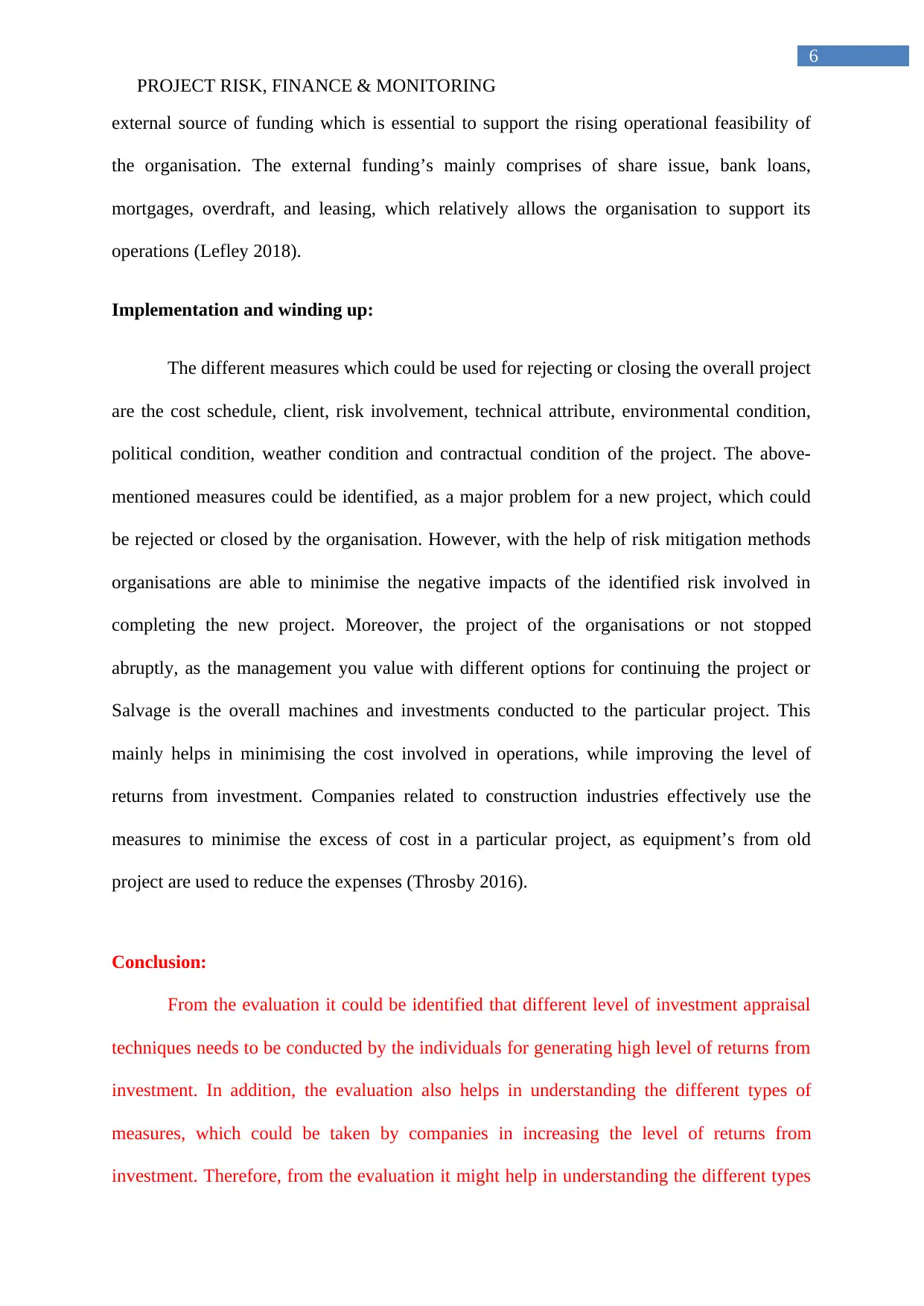
PROJECT RISK, FINANCE & MONITORING
6
external source of funding which is essential to support the rising operational feasibility of
the organisation. The external funding’s mainly comprises of share issue, bank loans,
mortgages, overdraft, and leasing, which relatively allows the organisation to support its
operations (Lefley 2018).
Implementation and winding up:
The different measures which could be used for rejecting or closing the overall project
are the cost schedule, client, risk involvement, technical attribute, environmental condition,
political condition, weather condition and contractual condition of the project. The above-
mentioned measures could be identified, as a major problem for a new project, which could
be rejected or closed by the organisation. However, with the help of risk mitigation methods
organisations are able to minimise the negative impacts of the identified risk involved in
completing the new project. Moreover, the project of the organisations or not stopped
abruptly, as the management you value with different options for continuing the project or
Salvage is the overall machines and investments conducted to the particular project. This
mainly helps in minimising the cost involved in operations, while improving the level of
returns from investment. Companies related to construction industries effectively use the
measures to minimise the excess of cost in a particular project, as equipment’s from old
project are used to reduce the expenses (Throsby 2016).
Conclusion:
From the evaluation it could be identified that different level of investment appraisal
techniques needs to be conducted by the individuals for generating high level of returns from
investment. In addition, the evaluation also helps in understanding the different types of
measures, which could be taken by companies in increasing the level of returns from
investment. Therefore, from the evaluation it might help in understanding the different types
6
external source of funding which is essential to support the rising operational feasibility of
the organisation. The external funding’s mainly comprises of share issue, bank loans,
mortgages, overdraft, and leasing, which relatively allows the organisation to support its
operations (Lefley 2018).
Implementation and winding up:
The different measures which could be used for rejecting or closing the overall project
are the cost schedule, client, risk involvement, technical attribute, environmental condition,
political condition, weather condition and contractual condition of the project. The above-
mentioned measures could be identified, as a major problem for a new project, which could
be rejected or closed by the organisation. However, with the help of risk mitigation methods
organisations are able to minimise the negative impacts of the identified risk involved in
completing the new project. Moreover, the project of the organisations or not stopped
abruptly, as the management you value with different options for continuing the project or
Salvage is the overall machines and investments conducted to the particular project. This
mainly helps in minimising the cost involved in operations, while improving the level of
returns from investment. Companies related to construction industries effectively use the
measures to minimise the excess of cost in a particular project, as equipment’s from old
project are used to reduce the expenses (Throsby 2016).
Conclusion:
From the evaluation it could be identified that different level of investment appraisal
techniques needs to be conducted by the individuals for generating high level of returns from
investment. In addition, the evaluation also helps in understanding the different types of
measures, which could be taken by companies in increasing the level of returns from
investment. Therefore, from the evaluation it might help in understanding the different types
Paraphrase This Document
Need a fresh take? Get an instant paraphrase of this document with our AI Paraphraser

PROJECT RISK, FINANCE & MONITORING
7
of measures, which could be taken by companies in improving the level of returns from
investment.
7
of measures, which could be taken by companies in improving the level of returns from
investment.
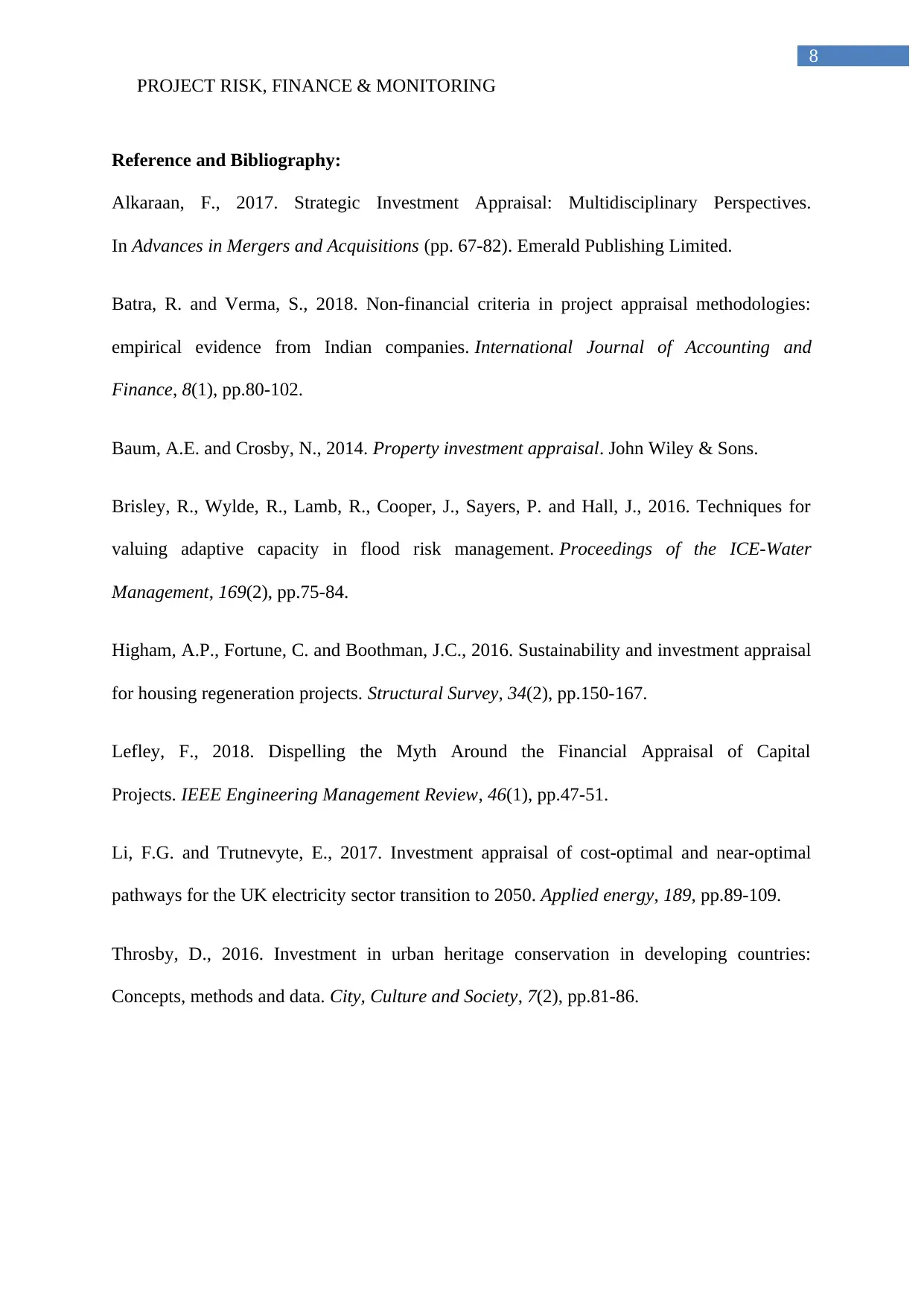
PROJECT RISK, FINANCE & MONITORING
8
Reference and Bibliography:
Alkaraan, F., 2017. Strategic Investment Appraisal: Multidisciplinary Perspectives.
In Advances in Mergers and Acquisitions (pp. 67-82). Emerald Publishing Limited.
Batra, R. and Verma, S., 2018. Non-financial criteria in project appraisal methodologies:
empirical evidence from Indian companies. International Journal of Accounting and
Finance, 8(1), pp.80-102.
Baum, A.E. and Crosby, N., 2014. Property investment appraisal. John Wiley & Sons.
Brisley, R., Wylde, R., Lamb, R., Cooper, J., Sayers, P. and Hall, J., 2016. Techniques for
valuing adaptive capacity in flood risk management. Proceedings of the ICE-Water
Management, 169(2), pp.75-84.
Higham, A.P., Fortune, C. and Boothman, J.C., 2016. Sustainability and investment appraisal
for housing regeneration projects. Structural Survey, 34(2), pp.150-167.
Lefley, F., 2018. Dispelling the Myth Around the Financial Appraisal of Capital
Projects. IEEE Engineering Management Review, 46(1), pp.47-51.
Li, F.G. and Trutnevyte, E., 2017. Investment appraisal of cost-optimal and near-optimal
pathways for the UK electricity sector transition to 2050. Applied energy, 189, pp.89-109.
Throsby, D., 2016. Investment in urban heritage conservation in developing countries:
Concepts, methods and data. City, Culture and Society, 7(2), pp.81-86.
8
Reference and Bibliography:
Alkaraan, F., 2017. Strategic Investment Appraisal: Multidisciplinary Perspectives.
In Advances in Mergers and Acquisitions (pp. 67-82). Emerald Publishing Limited.
Batra, R. and Verma, S., 2018. Non-financial criteria in project appraisal methodologies:
empirical evidence from Indian companies. International Journal of Accounting and
Finance, 8(1), pp.80-102.
Baum, A.E. and Crosby, N., 2014. Property investment appraisal. John Wiley & Sons.
Brisley, R., Wylde, R., Lamb, R., Cooper, J., Sayers, P. and Hall, J., 2016. Techniques for
valuing adaptive capacity in flood risk management. Proceedings of the ICE-Water
Management, 169(2), pp.75-84.
Higham, A.P., Fortune, C. and Boothman, J.C., 2016. Sustainability and investment appraisal
for housing regeneration projects. Structural Survey, 34(2), pp.150-167.
Lefley, F., 2018. Dispelling the Myth Around the Financial Appraisal of Capital
Projects. IEEE Engineering Management Review, 46(1), pp.47-51.
Li, F.G. and Trutnevyte, E., 2017. Investment appraisal of cost-optimal and near-optimal
pathways for the UK electricity sector transition to 2050. Applied energy, 189, pp.89-109.
Throsby, D., 2016. Investment in urban heritage conservation in developing countries:
Concepts, methods and data. City, Culture and Society, 7(2), pp.81-86.
⊘ This is a preview!⊘
Do you want full access?
Subscribe today to unlock all pages.

Trusted by 1+ million students worldwide
1 out of 9
Related Documents
Your All-in-One AI-Powered Toolkit for Academic Success.
+13062052269
info@desklib.com
Available 24*7 on WhatsApp / Email
![[object Object]](/_next/static/media/star-bottom.7253800d.svg)
Unlock your academic potential
Copyright © 2020–2025 A2Z Services. All Rights Reserved. Developed and managed by ZUCOL.



